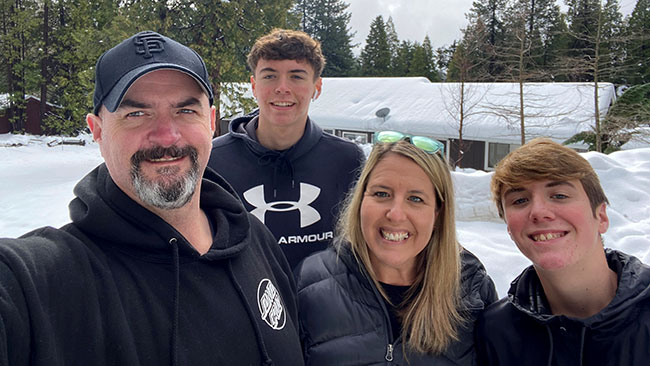Nonsmoker surprised by lung cancer diagnosis
A lifelong nonsmoker was shocked by lung cancer diagnosis, but thanks to early detection and an innovative VATS procedure, she's now a cancer survivor.

Stephens and her family enjoy spending time together outdoors.
When Mariann Stephens learned she had lung cancer, she couldn’t believe it.
“I’ve never smoked in my entire life,” said the first-grade teacher and mother of 2 from Pleasanton, California. “This was a total curveball.”
Lung cancer is by far the leading cause of cancer death in the United States. And nearly 9 out of 10 lung cancers are caused by smoking cigarettes, according to the Centers for Disease Control and Prevention.
But many people don’t realize that 1 in every 5 people who die from lung cancer are nonsmokers and have never used tobacco.
Saved by early detection
Stephens’ lung cancer story began on Valentine’s Day in 2013 when she was diagnosed with severe pneumonia. She spent a week in the hospital and was left with substantial scarring on both lungs. Her doctors recommended annual screenings to monitor the impact of the scarring.
After years of surveillance, a CT scan showed that a small nodule on her right lung had changed and grown.
“It turns out the pneumonia was both a curse and a blessing,” said Stephens. “If it weren’t for my pneumonia, I wouldn’t have been going in for annual scans, and the nodule could still be growing inside me. I feel like I dodged a huge bullet.”
Combining lung cancer diagnosis and treatment
Stephens’ doctor referred her to Jeffrey Velotta, MD, a thoracic surgeon at the Kaiser Permanente Oakland Medical Center. Dr. Velotta recommended surgery to take a small tissue sample and test it for cancer immediately. The results came while Stephens was still on the operating table.
“It’s diagnosis and treatment at the same time,” Dr. Velotta explained. “Nodules like this are often hard to diagnose because they’re so small. Our lung cancer program has a system in place where I can send a sample downstairs to a specialist in lung pathology and get a 99%-accurate diagnosis in less than 30 minutes.”
The test showed that the nodule was cancerous. Dr. Velotta surgically removed the upper right lobe of Stephens’ lung and affected lymph nodes.
He used video-assisted thoracoscopic surgery, or VATS. In this minimally invasive procedure, a tiny camera known as a videoscope and small surgical tools are inserted into the patient’s chest through small cuts made between the ribs.
Research by Dr. Velotta and his colleagues has shown that this approach contributes to lower complication rates, less postoperative pain, and higher quality of life than traditional surgery.
Stephens was able to return home shortly after her procedure and recovered quickly. VATS patients typically recover from surgery within 2 weeks, while it can take 6 to 8 weeks to recover from traditional surgery.
“I’m so thankful he was able to do everything in one shot,” said Stephens. “It saved me unnecessary steps and extra procedures. They were able to remove all the cancer, so I didn’t need chemo or radiation.”
Lung cancer survivor: ‘I owe him my whole life’
 Stephens with her dog, Cali.
Stephens with her dog, Cali.
Stephens is now a lung cancer survivor. She’s back at school teaching her students. And she loves spending time in the mountains with her family, taking walks, and enjoying the scenery.
“Dr. Velotta is my hero. I owe him my whole life,” she said.
Learn more about cancer care at Kaiser Permanente.
Lung cancer symptoms and prevention
The most common symptoms of lung cancer include:
- Wheezing
- Shortness of breath
- A new cough or a cough that doesn’t go away
- Coughing up blood or bloody mucus
- Chest, shoulder, or back pain that doesn't go away and gets worse with deep breathing
Some lung cancers can’t be prevented. But if you smoke, quitting smoking is the best step you can take to prevent lung cancer.
If you want to quit, your doctor can recommend medicines or other ways to help.